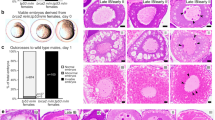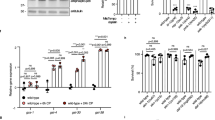Abstract
Bmyb is a ubiquitously expressed transcription factor involved in cellular proliferation and cancer1,2,3,4. Loss of bmyb function in the zebrafish mutant crash&burn (crb) results in decreased cyclin B1 expression, mitotic arrest and genome instability5. These phenotypic observations in crb mutants could be attributed to the decreased expression of cyclin B1, a cell-cycle regulatory protein that is responsible for driving cell progression from G2 through mitosis. To identify small molecules that interact with the bmyb pathway, we developed an embryo-based suppressor screening strategy. In 16 weeks we screened a diverse ∼16,000 compound library, and discovered one previously unknown compound, persynthamide (psy, 1), that suppressed bmyb-dependent mitotic defects. Psy- treated embryos showed an S-phase delay, and knockdown of the cell-cycle checkpoint regulator ataxia telangiectasia—and Rad-related kinase (ATR) abrogated the suppression of crb. The DNA synthesis inhibitors aphidicolin (2) and hydroxyurea (3) also suppressed crb. S-phase inhibition upregulated cyclin B1 mRNA, promoting the progression of cells through mitosis. Our study demonstrates that chemical suppressor screening in zebrafish can identify compounds with cell-cycle activity and can be used to identify pathways that interact with specific cell-cycle phenotypes.
This is a preview of subscription content, access via your institution
Access options
Subscribe to this journal
Receive 12 print issues and online access
$259.00 per year
only $21.58 per issue
Buy this article
- Purchase on Springer Link
- Instant access to full article PDF
Prices may be subject to local taxes which are calculated during checkout




Similar content being viewed by others
References
Sala, A. & Watson, R. B-Myb protein in cellular proliferation, transcription control, and cancer: latest developments. J. Cell. Physiol. 179, 245–250 (1999).
Oh, I.H. & Reddy, E.P. The myb gene family in cell growth, differentiation and apoptosis. Oncogene 18, 3017–3033 (1999).
Joaquin, M. & Watson, R.J. Cell cycle regulation by the B-Myb transcription factor. Cell. Mol. Life Sci. 60, 2389–2401 (2003).
Bessa, M., Joaquin, M., Tavner, F., Saville, M.K. & Watson, R.J. Regulation of the cell cycle by B-Myb. Blood Cells Mol. Dis. 27, 416–421 (2001).
Shepard, J.L. et al. A zebrafish bmyb mutation causes genome instability and increased cancer susceptibility. Proc. Natl. Acad. Sci. USA 102, 13194–13199 (2005).
Peterson, R.T., Link, B.A., Dowling, J.E. & Schreiber, S.L. Small molecule developmental screens reveal the logic and timing of vertebrate development. Proc. Natl. Acad. Sci. USA 97, 12965–12969 (2000).
Khersonsky, S.M. et al. Facilitated forward chemical genetics using a tagged triazine library and zebrafish embryo screening. J. Am. Chem. Soc. 125, 11804–11805 (2003).
Hendzel, M.J. et al. Mitosis-specific phosphorylation of histone H3 initiates primarily within pericentromeric heterochromatin during G2 and spreads in an ordered fashion coincident with mitotic chromosome condensation. Chromosoma 106, 348–360 (1997).
Nasevicius, A. & Ekker, S.C. Effective targeted gene 'knockdown' in zebrafish. Nat. Genet. 26, 216–220 (2000).
Feijoo, C. et al. Activation of mammalian Chk1 during DNA replication arrest: a role for Chk1 in the intra-S phase checkpoint monitoring replication origin firing. J. Cell Biol. 154, 913–923 (2001).
Sorensen, C.S. et al. Chk1 regulates the S phase checkpoint by coupling the physiological turnover and ionizing radiation-induced accelerated proteolysis of Cdc25A. Cancer Cell 3, 247–258 (2003).
Zou, L. & Elledge, S.J. Sensing DNA damage through ATRIP recognition of RPA-ssDNA complexes. Science 300, 1542–1548 (2003).
Donaldson, A.D. & Blow, J.J. DNA replication: stable driving prevents fatal smashes. Curr. Biol. 11, R979–R982 (2001).
Tercero, J.A., Longhese, M.P. & Diffley, J.F. A central role for DNA replication forks in checkpoint activation and response. Mol. Cell 11, 1323–1336 (2003).
Shiloh, Y. ATM and ATR: networking cellular responses to DNA damage. Curr. Opin. Genet. Dev. 11, 71–77 (2001).
Costanzo, V. et al. An ATR- and Cdc7-dependent DNA damage checkpoint that inhibits initiation of DNA replication. Mol. Cell 11, 203–213 (2003).
Cortez, D. Caffeine inhibits checkpoint responses without inhibiting the ataxia-telangiectasia-mutated (ATM) and ATM- and Rad3-related (ATR) protein kinases. J. Biol. Chem. 278, 37139–37145 (2003).
Okada, M., Akimaru, H., Hou, D.X., Takahashi, T. & Ishii, S. Myb controls G(2)/M progression by inducing cyclin B expression in the Drosophila eye imaginal disc. EMBO J. 21, 675–684 (2002).
Zhu, W., Giangrande, P.H. & Nevins, J.R. E2Fs link the control of G1/S and G2/M transcription. EMBO J. 23, 4615–4626 (2004).
Stern, H.M. & Zon, L.I. Cancer genetics and drug discovery in the zebrafish. Nat. Rev. Cancer 3, 533–539 (2003).
MacRae, C.A. & Peterson, R.T. Zebrafish-based small molecule discovery. Chem. Biol. 10, 901–908 (2003).
Pichler, F.B. et al. Chemical discovery and global gene expression analysis in zebrafish. Nat. Biotechnol. 21, 879–883 (2003).
Peterson, R.T., Mably, J.D., Chen, J.N. & Fishman, M.C. Convergence of distinct pathways to heart patterning revealed by the small molecule concentramide and the mutation heart-and-soul. Curr. Biol. 11, 1481–1491 (2001).
Peterson, R.T. et al. Chemical suppression of a genetic mutation in a zebrafish model of aortic coarctation. Nat. Biotechnol. 22, 595–599 (2004).
Berghmans, S. et al. tp53 mutant zebrafish develop malignant peripheral nerve sheath tumors. Proc. Natl. Acad. Sci. USA 102, 407–412 (2005).
Amsterdam, A. et al. Many ribosomal protein genes are cancer genes in zebrafish. PLoS Biol. 2, E139 (2004).
Langenau, D.M. et al. Myc-induced T cell leukemia in transgenic zebrafish. Science 299, 887–890 (2003).
Patton, E.E. et al. BRAF mutations are sufficient to promote nevi formation and cooperate with p53 in the genesis of melanoma. Curr. Biol. 15, 249–254 (2005).
Acknowledgements
We would like to thank D. Hayes, J. Follen and C. Shamu for help with small-molecule screening, T. Mitchison for helpful advice, and C. Burns, J. DeCaprio, N. Dyson, I. Hariharan and W. Kaelin for critical comments on the manuscript. We also thank R. Finley for help with in situ hybridization, R. Wingert for providing reagents and C. Belair and B. Barut for expert laboratory management. This work was supported by NIH grants 5K08 DK061849 (H.M.S.), 1R01 DK55381 (L.I.Z.), 1R01 HD044930 (L.I.Z.) and 5K08 HL04082 (J.F.A.). L.I.Z. is an Investigator of the Howard Hughes Medical Institute.
Author information
Authors and Affiliations
Corresponding author
Ethics declarations
Competing interests
The authors declare no competing financial interests.
Supplementary information
Supplementary Fig. 1
Schematic representation of the screen. (PDF 946 kb)
Supplementary Fig. 2
Confirmation of chemical composition of persynthamide. (PDF 289 kb)
Supplementary Fig. 3
Persynthamide is required during a specific developmental time window to suppress crb. (PDF 129 kb)
Supplementary Fig. 4
Counts of spindles and centrosomes in tails of psy-treated and untreated embryos. (PDF 737 kb)
Supplementary Fig. 5
Persynthamide-, aphidocolin- and hydroxyurea- treated embryos have similar gene expression profiles. (PDF 914 kb)
Supplementary Fig. 6
Cyclin B1 levels are upregulated by S-phase inhibitors. (PDF 592 kb)
Supplementary Fig. 7
Model of how S-phase delay via the intra-S-phase checkpoint may suppress the bmyb loss of function mutant crb by increasing cyclin B1 message. (PDF 1028 kb)
Rights and permissions
About this article
Cite this article
Stern, H., Murphey, R., Shepard, J. et al. Small molecules that delay S phase suppress a zebrafish bmyb mutant. Nat Chem Biol 1, 366–370 (2005). https://doi.org/10.1038/nchembio749
Received:
Accepted:
Published:
Issue Date:
DOI: https://doi.org/10.1038/nchembio749
This article is cited by
-
Zebrafish disease models in drug discovery: from preclinical modelling to clinical trials
Nature Reviews Drug Discovery (2021)
-
Zebrafish: an emerging real-time model system to study Alzheimer’s disease and neurospecific drug discovery
Cell Death Discovery (2018)
-
Small molecule screen in embryonic zebrafish using modular variations to target segmentation
Nature Communications (2017)
-
ARQiv-HTS, a versatile whole-organism screening platform enabling in vivo drug discovery at high-throughput rates
Nature Protocols (2016)
-
A fresh look at zebrafish from the perspective of cancer research
Journal of Experimental & Clinical Cancer Research (2015)



